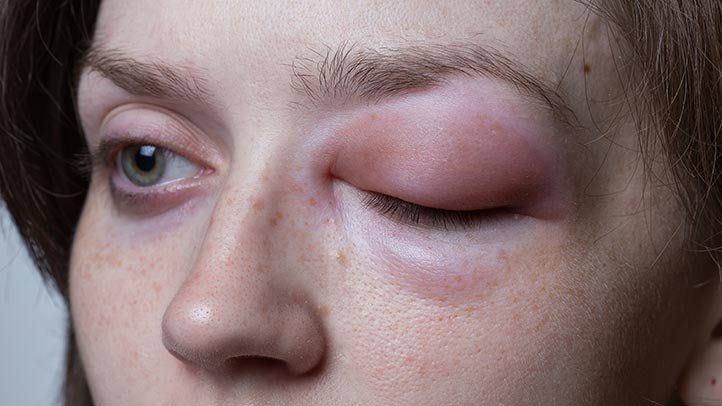Angioedema is recognized by superficial swelling in various body parts, including the face, throat, larynx, uvula, arms, hands, and feet. It can also affect the genitals and intestines.
Affected areas might become red, painful, or warm, featuring large, thick, solid welts. If angioedema reaches the lower intestine, it may cause stomachaches. The condition can become dangerous if it leads to tongue or throat swelling, potentially blocking airways and making breathing difficult.
Types of Angioedema
There are four primary types of angioedema, each with its unique causes and triggers:
Allergic Angioedema: This is the most prevalent type and can be triggered by allergic reactions to foods such as shellfish, peanuts, tree nuts, eggs, and milk. Other triggers include pollens, animal dander, latex, insect stings, and medications like penicillin, aspirin, and other non-steroidal anti-inflammatory drugs (NSAIDs).
Hereditary Angioedema (HAE): This rare condition results from the body’s inability to produce sufficient C1 esterase inhibitors, a blood protein. This deficiency permits blood to leak into various tissues, causing angioedema.
Acquired Angioedema: Similar to HAE, acquired angioedema generally occurs after the age of 40 and is linked to a weakened immune system. Unlike HAE, it is not inherited.
Idiopathic Angioedema: This type involves swelling of unknown origin. Possible causes may include anxiety, stress, minor infections, and extreme temperatures.
Symptoms of Angioedema
Symptoms may include:
- Puffy or swollen face, especially around the eyes, mouth, lips, and tongue
- Digestive issues due to swollen intestines, including abdominal pain, diarrhea, nausea, and vomiting
- Swollen hands, feet, or genitals
- Dizziness or fainting
- Swelling in the mouth, throat, or airways, making it difficult to speak and breathe
Who Can Get Angioedema?
The risk of developing angioedema is higher if you:
- Have a history of hives, allergic reactions, or angioedema
- Suffer from conditions such as lupus, lymphoma, thyroid disease, hepatitis, HIV, cytomegalovirus, Epstein-Barr virus, or have had a blood transfusion
- Have a family history of hives
- Have asthma
- Have taken NSAIDs
- Have used ACE inhibitors
- Have undergone recombinant tissue plasminogen activator therapy for a stroke
Treatment
Angioedema usually resolves on its own within a few days. If treatment is required, it may include:
- Antihistamines and oral corticosteroids to reduce swelling and inflammation
- Medications that suppress the immune system if antihistamines and corticosteroids are ineffective
- Leukotriene antagonists, a type of NSAID that reduces pain and swelling
- Blood protein controllers for hereditary angioedema
If a medication is the cause, your doctor will likely prescribe a different drug more suited to your condition.
Prevention
Preventing allergic episodes of angioedema involves avoiding known triggers like specific foods, medications, or other circumstances that cause swelling. Keeping a diary to note foods, situations, and triggers related to your symptoms can be helpful if you’re uncertain about the causes.
Your doctor may recommend taking antihistamines daily rather than as needed. This can lead to fewer episodes, reduced severity, and enhanced safety.
